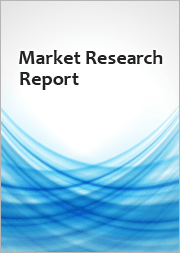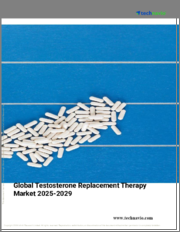
|
시장보고서
상품코드
1566149
테스토스테론 보충 요법 시장 규모, 점유율, 성장 분석, 제품 유형별, 유효 성분별, 최종사용자별, 지역별 - 산업 예측(2024-2031년)Testosterone Replacement Therapy Market Size, Share, Growth Analysis, By Product Type, By Active ingredients, By End User, By Region - Industry Forecast 2024-2031 |
||||||
세계의 테스토스테론 보충 요법 시장 규모는 2022년에 약 14억 달러로 평가되며, 예측 기간(2024-2031년)의 CAGR은 8.9%로, 2023년 15억 달러에서 상승하며, 2031년에는 29억 달러에 달할 것으로 예측됩니다.
고령화, 생활습관 변화, 스트레스 증가 등 테스토스테론 결핍증을 증가시키는 요인들이 복합적으로 작용하면서 세계 테스토스테론 보충 요법(TRT) 시장은 크게 성장하고 있으며, TRT는 테스토스테론 수치 저하를 정확하게 진단하고 관리하는 데 필수적인 진단 테스트 및 모니터링 장비와 함께 주사, 젤, 패치, 펠릿 등 다양한 제품 및 치료 방법을 포괄하고 있습니다. 테스토스테론 생산은 나이가 들면서 자연적으로 감소하므로 효과적인 치료 옵션에 대한 수요가 증가하고 있으며, 고령화 인구가 주요 동력이 되고 있습니다. 또한 의료 전문가들은 결핍을 진단하고 적절한 치료를 처방하고 환자의 안전과 치료 효과를 보장함으로써 이 시장에서 중요한 역할을 담당하고 있습니다. 제약회사와 클리닉이 주도하는 지속적인 연구개발 노력으로 시장은 새롭고 혁신적인 TRT 솔루션을 도입하기 위해 진화하고 있습니다. 이러한 성장 추세는 미국 시장에서 두드러지게 나타나고 있으며, 향후 수년간 지속적인 연평균 성장률(CAGR)을 유지할 것으로 예상됩니다. 테스토스테론 보충 요법에 대한 수요가 지속적으로 증가함에 따라 이 시장은 결핍을 경험하는 사람들의 삶의 질을 향상시키고, 더 넓은 제약 및 의료 분야에서 그 중요성을 입증하고 있습니다. 전반적으로 TRT 시장은 진화하는 인구의 의료 수요에 대응하기 위해 점점 더 중요해지고 있습니다.
목차
서론
- 조사의 목적
- 정의
- 시장 범위
조사 방법
- 정보 조달
- 2차 데이터 소스와 1차 데이터 소스
- 시장 규모 예측
- 시장의 상정과 제한
개요
- 시장 개요 전망
- 공급 수요 동향 분석
- 부문별 기회 분석
시장 역학과 전망
- 시장 역학
- 촉진요인
- 기회
- 억제요인
- 과제
- Porter의 산업 분석
주요 시장 인사이트
- 주요 성공 요인
- 경쟁의 정도
- 주요 투자 기회
- 시장의 에코시스템
- 규제 분석
- 사례 연구 분석
- 특허 분석
- 가격 분석
테스토스테론 보충 요법 시장 : 제품 유형별
- 시장 개요
- 주사
- 외용
- 기타
테스토스테론 보충 요법 시장 : 유효 성분별
- 시장 개요
- Testosterone Undecanoate
- Testosterone Cypionate
- Testosterone
- Testosterone Enanthate
- 기타
테스토스테론 보충 요법 시장 : 최종사용자별
- 시장 개요
- 병원
- 클리닉
테스토스테론 보충 요법 시장 규모 : 지역별
- 시장 개요
- 북미
- 미국
- 캐나다
- 유럽
- 독일
- 스페인
- 프랑스
- 영국
- 이탈리아
- 기타 유럽 지역
- 아시아태평양
- 중국
- 인도
- 일본
- 한국
- 기타 아시아태평양
- 라틴아메리카
- 브라질
- 기타 라틴아메리카 지역
- 중동 및 아프리카(MEA)
- GCC 국가
- 남아프리카공화국
- 기타 중동 및 아프리카 지역
경쟁 구도
- 상위 5사의 비교
- 주요 기업의 시장 포지셔닝(2023년)
- 주요 시장 기업이 채택한 전략
- 시장에서의 최근 활동
- 주요 기업의 시장 점유율(2023년)
주요 기업 개요
- AbbVie Inc.
- Pfizer Inc.
- Endo International plc
- Teva Pharmaceutical Industries Ltd.
- Bausch Health Companies Inc.
- Acerus Pharmaceuticals Corporation
- Marius Pharmaceuticals
- Insud Pharma S.L.
- Allergan
- Hikma Pharmaceuticals PLC
- Cipla Inc.
- Sun Pharmaceutical Industries Ltd.
- Lupin Pharmaceuticals
- Novartis AG
- AstraZeneca
Global Testosterone Replacement Therapy Market size was valued at around USD 1.4 billion in 2022 and is expected to rise from USD 1.5 billion in 2023 to reach a value of USD 2.9 billion by 2031, at a CAGR of 8.9% over the forecast period (2024-2031).
The Global Testosterone Replacement Therapy (TRT) market is experiencing significant growth, driven by a confluence of factors including an aging population, lifestyle changes, and an increase in stress levels, which have all contributed to rising testosterone deficiencies. TRT encompasses a range of products and treatment modalities such as injections, gels, patches, and pellets, alongside diagnostic tests and monitoring devices essential for accurate diagnosis and management of low testosterone levels. The aging demographic is a key driver, as testosterone production naturally declines with age, leading to a greater need for effective therapy options. Additionally, healthcare professionals play a crucial role in this market by diagnosing deficiencies, prescribing suitable treatments, and ensuring patient safety and treatment efficacy. With ongoing research and development efforts spearheaded by pharmaceutical companies and clinics, the market is evolving to introduce new and innovative TRT solutions. This growth trend is underscored in the US market, which is projected to maintain a sustainable compound annual growth rate (CAGR) in the upcoming years. As the demand for testosterone replacement therapy continues to rise, the market is positioned to enhance the quality of life for individuals experiencing deficiencies, marking its significance within the broader pharmaceutical and medical sectors. Overall, the TRT market is becoming increasingly vital as it seeks to address the healthcare needs of an evolving population.
Top-down and bottom-up approaches were used to estimate and validate the size of the Global Testosterone Replacement Therapy market and to estimate the size of various other dependent submarkets. The research methodology used to estimate the market size includes the following details: The key players in the market were identified through secondary research, and their market shares in the respective regions were determined through primary and secondary research. This entire procedure includes the study of the annual and financial reports of the top market players and extensive interviews for key insights from industry leaders such as CEOs, VPs, directors, and marketing executives. All percentage shares split, and breakdowns were determined using secondary sources and verified through Primary sources. All possible parameters that affect the markets covered in this research study have been accounted for, viewed in extensive detail, verified through primary research, and analyzed to get the final quantitative and qualitative data.
Global Testosterone Replacement Therapy Market Segmental Analysis
Global Testosterone Replacement Therapy Market is segmented by Product Type, Active ingredients, End User, and region. Based on Product Type, the market is segmented into Injectables, Topical, and Others. Based on Active ingredients, the market is segmented into Testosterone Undecanoate, Testosterone Cypionate, Testosterone, Testosterone Enanthate, and Others. Based on End User, the market is segmented into Hospitals, Clinics. Based on region, the market is segmented into North America, Europe, Asia Pacific, Latin America and Middle East & and Africa.
Driver of the Global Testosterone Replacement Therapy Market
The growing prevalence of testosterone insufficiency, especially among males aged 40 to 79, is a significant market driver for the global testosterone replacement therapy (TRT) market. With approximately 20% of men over 60 and 30% over 70 experiencing low testosterone levels, combined with an estimated 10% to 40% of the global male population affected by this condition, the demand for effective TRT solutions is surging. Additionally, the upward trajectory of the elderly demographic further compounds this need, creating increased awareness and acceptance of TRT as a viable treatment option, thereby propelling market growth and innovation in therapeutic offerings.
Restraints in the Global Testosterone Replacement Therapy Market
The global testosterone replacement therapy market faces significant restraints due to the substantial risk of various post-treatment complications, including sleep apnea, acne, gynecomastia, and heightened risk of thromboembolic events. These potential side effects deter patients and healthcare providers from pursuing treatment, thereby inhibiting market growth. Additionally, the high costs associated with testosterone therapy, coupled with the need for ongoing medical supervision and potential follow-up treatments, further limits accessibility for patients. These combined factors contribute to hesitance among both consumers and practitioners, ultimately stifling the demand and expansion of the testosterone replacement therapy market on a global scale.
Market Trends of the Global Testosterone Replacement Therapy Market
The global testosterone replacement therapy (TRT) market is experiencing a notable shift towards personalized treatment options, catering to individual patient needs. This trend has spurred the growth of compounding pharmacies that offer customizable formulations. In tandem, pharmaceutical companies are innovating delivery methods, introducing products like nasal sprays and transdermal patches to enhance treatment convenience and efficacy. Additionally, an integrated approach combining TRT with lifestyle changes is gaining traction, advocating for holistic hormone management. The rise of digital health technologies further transforms the market, with telemedicine facilitating remote consultations, while mobile apps monitor hormone levels, ultimately improving patient access and engagement in their TRT journey.
Table of Contents
Introduction
- Objectives of the Study
- Definitions
- Market Scope
Research Methodology
- Information Procurement
- Secondary & Primary Data Sources
- Market Size Estimation
- Market Assumptions & Limitations
Executive Summary
- Market Overview Outlook
- Supply Demand Trend Analysis
- Segmental Opportunity Analysis
Market Dynamics & Outlook
- Market Dynamics
- Drivers
- Opportunities
- Restraints
- Challenges
- Porters Analysis
- Competitive rivalry
- Threat of Substitute Products
- Bargaining Power of Buyers
- Threat of New Entrants
- Bargaining Power of Suppliers
Key Market Insights
- Key Success Factor
- Degree of Competition
- Top Investment Pockets
- Ecosystem of the Market
- Regulatory Analysis
- Case Study Analysis
- Patent Analysis
- Pricing Analysis
Testosterone Replacement Therapy Market, By Product Type
- Market Overview
- Injectables
- Topical
- Others
Testosterone Replacement Therapy Market, By Active ingredients
- Market Overview
- Testosterone Undecanoate
- Testosterone Cypionate
- Testosterone
- Testosterone Enanthate
- Others
Testosterone Replacement Therapy Market, By End User
- Market Overview
- Hospital
- Clinics
Testosterone Replacement Therapy Market Size by Region
- Market Overview
- North America
- USA
- Canada
- Europe
- Germany
- Spain
- France
- UK
- Italy
- Rest of Europe
- Asia Pacific
- China
- India
- Japan
- South Korea
- Rest of Asia-Pacific
- Latin America
- Brazil
- Rest of Latin America
- Middle East & Africa (MEA)
- GCC Countries
- South Africa
- Rest of MEA
Competitive Landscape
- Top 5 Player Comparison
- Market Positioning of Key Players, 2023
- Strategies Adopted by Key Market Players
- Recent Activities in the Market
- Key Companies Market Share (%), 2023
Key Company Profiles
- AbbVie Inc.
- Company Overview
- Business Segment Overview
- Financial Updates
- Key Developments
- Pfizer Inc.
- Company Overview
- Business Segment Overview
- Financial Updates
- Key Developments
- Endo International plc
- Company Overview
- Business Segment Overview
- Financial Updates
- Key Developments
- Teva Pharmaceutical Industries Ltd.
- Company Overview
- Business Segment Overview
- Financial Updates
- Key Developments
- Bausch Health Companies Inc.
- Company Overview
- Business Segment Overview
- Financial Updates
- Key Developments
- Acerus Pharmaceuticals Corporation
- Company Overview
- Business Segment Overview
- Financial Updates
- Key Developments
- Marius Pharmaceuticals
- Company Overview
- Business Segment Overview
- Financial Updates
- Key Developments
- Insud Pharma S.L.
- Company Overview
- Business Segment Overview
- Financial Updates
- Key Developments
- Allergan
- Company Overview
- Business Segment Overview
- Financial Updates
- Key Developments
- Hikma Pharmaceuticals PLC
- Company Overview
- Business Segment Overview
- Financial Updates
- Key Developments
- Cipla Inc.
- Company Overview
- Business Segment Overview
- Financial Updates
- Key Developments
- Sun Pharmaceutical Industries Ltd.
- Company Overview
- Business Segment Overview
- Financial Updates
- Key Developments
- Lupin Pharmaceuticals
- Company Overview
- Business Segment Overview
- Financial Updates
- Key Developments
- Novartis AG
- Company Overview
- Business Segment Overview
- Financial Updates
- Key Developments
- AstraZeneca
- Company Overview
- Business Segment Overview
- Financial Updates
- Key Developments



















